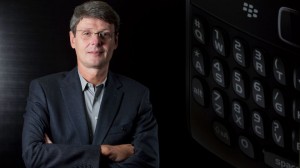
In brief remarks to reporters Wednesday, RIM CEO Thorsten Heins revealed little of RIM’s specific plans for the future but confirmed his determination to rebuild RIM as a “mobile computing” powerhouse, going beyond smartphones and tablets.
Heins did say that RIM would release a 4G-equipped BlackBerry PlayBook later this year, presumably with the company’s BlackBerry 10 operating system, which he said was nearing completion. In the interim, and for the next couple of years, RIM will continue to actively develop and support the BlackBerry 7 operating system, which is a key part of RIM’s continuing efforts globally to shift users from feature phones to smartphones.
And Heins laid to rest what he said were surprising conclusions by reporters and bloggers that RIM’s distinctive physical keypad would be missing from the upcoming BlackBerry 10 phone models. “Will there be a physical keypad option in the BlackBerry 10 portfolio?” a reporter asked.
“The physical keypad will be an option in the BlackBerry 10 portfolio,” he replied.
In remarks earlier Heins said, “There was no comment [at the Tuesday keynote] that ‘we will not build physical keypads,'” he said. “We’re the best physical keypad on the planet. We only showed one element of BlackBerry 10 [a demo of a all-touch prototype unit]. There are many others. We’re not going to lose the focus on physical keypads.”
Heins has been CEO for just 12 weeks. He took charge of RIM’s hardware products when he joined the company in 2007, and then gained responsibilities to keep BlackBerry 7 on track when development ran into problems, and then to deliver the PlayBook OS, the forerunner of BB10. That background, his comments at this week’s BlackBerry World keynote and the brief exchange with reporters suggest that there’s a tough core of determination and competitive drive under his laid-back, quiet-spoken mannerisms.
He’ll need every bit of it. In response to a question, Heins reiterated that he had been surprised by the depth and breadth of RIM’s difficulties after becoming CEO.
In his previous executive roles, “I was focused on what I was supposed to do,” he said. “The CEO role is a broader one. That’s when I had access to all the data… But I’m excited about the progress my management team has accomplished in three months.
Heins will complete that changeover, along with other changes to streamline RIM’s management structure, with the hiring of a chief marketing officer and COO.
RIM’s fast growth in years past created bureaucracy, redundancy, a loss of accountability and most of all a loss of focus, he said.
Heins has concluded after extensive and in-depth talks, especially with users, that RIM’s target customers are those with a common denominator of “striving to succeed in what they are trying to do.” In a mobile connected world, these people are struggling to manage the information and “channels” that they’re now part of.
The RIM chief made clear this is not a smartphone issue but a mobile computing issue that includes a new generation of embedded systems and sensors, which increasingly surround users. BlackBerry 10, based on the QNX Software real-time operating system RIM acquired in 2010, is intended not as a smartphone platform but as a mobile computing platform.
For both consumers and enterprise users, “I want to provide a cutting edge mobile computing platform, and then augment it with strong partnerships with application and services providers,” Heins said.
“We’re nearing completion on BlackBerry 10,” Heins revealed. “Quality matters: I want the BlackBerry 10 experience to be perfect. I want to wow people. There’s much more to come than what you saw yesterday [in the conference keynote].”
To that end, RIM has begun talks with partners about the possibility of licensing BlackBerry 10 for a range of embedded systems and devices, including medical equipment, automotive telematics and entertainment systems, and smart grids, according to Heins. “RIM will be offering them the best mobile computing platform,” he said. There’s no talks or plans currently to license it to other smartphone or tablet makers.
The enterprise market remains important to RIM. “We had our enterprise pieces separated and fragmented,” he said. “Now we put them under [RIM CIO] Robin Bienfait. Now that we have, we’ll push the throttle pedal a bit more. I want to be No.1 in the enterprise, and I need BlackBery 10 as the platform [to do that].”
He acknowledged the steep slide of RIM’s U.S. market share, even in its traditional enterprise strongholds. “In the U.S., we have an uphill battle, there’s no question,” he admitted. “We are where we are. I’m convinced with the BlackBerry 10 portfolio, we will be a strong contender in the U.S. and gain market share.”
“I’m here to win,” he said. “I’m not here to just stay in the game.”
In the rest of the world, Heins said, “we’re still growing,” fueled by the entry-level BlackBerry smartphones that continue to “do very well.” Overseas, “we are under pressure there,” he said. “We have to compete there and we will.”
BlackBerry 7 still has a future in all markets as the basis of entry-level smartphones. “We won’t shut that down,” Heins said. RIM has a dedicated BB7 group, several hundred strong, in Raleigh, N.C. “We’re absolutely committed to an entry-level BlackBerry 7.”
But there should be no doubt about RIM’s direction. “A new platform is a new platform,” he said. “There can’t be compatibility [between them]. BlackBerry 7 is a strong smartphone base. BlackBerry 10 is a mobile computing base.”
RIM’s PlayBook Tablet has not been on overnight success. Heins said the company’s tablet focus currently is the enterprise.
“The question is ‘what is the real value of the tablet?'” he said. “The focus is on being an enterprise productivity success story, and then if that works, take it into the consumer space.” He said there would be a 4G PlayBook later this year but didn’t suggest that there would be new models or designs for the PlayBook beyond that.





